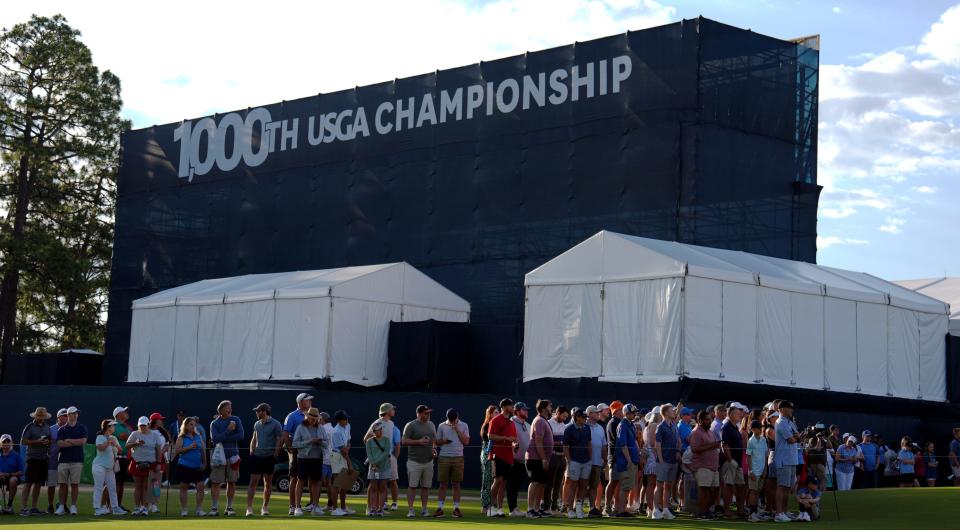2024 US Open: Everything to know about Pinehurst golf course ahead of 2024's third major

The 124th edition of the U.S. Open is coming our way Thursday as Pinehurst No. 2 Golf Course in North Carolina gears up for its first US Open in a decade, and the fourth time in 25 years.
Opened in 1907, it was nearly a century before Pinehurst No. 2 was given the opportunity to host a U.S. Open. Since that first one though, it's been a mainstay for the event. No other course in history has hosted four Opens in a 25-year span. Yet, the historic course, often referred to as the 'Cradle of American Golf,' will play host to this event even more often in the near future. In 2020, the USGA named Pinehurst one of its anchor sites, meaning the tournament will return to North Carolina in 2029, 2035, 2041, and 2047.
Pinehurst has been a U.S. Open mainstay. In fact, it's hosted three since 1999 ('99, '05, and '14). We no longer have to wait ten years for a major championship to return to Pinehurst.
Here are some facts to know about the course before the tournament starts on Thursday.
U.S. Open: Follow the U.S. Open live
Who won the other three U.S. Open tournaments played here?
1999 – Payne Stewart (-1)
2005 – Michael Campbell (E)
2014 – Martin Kaymer (-9)
The first thing you might notice is how high these scores are. Just last month, Xander Schauffele won the PGA Championship at -21. Just last year, Wydham Clark won the U.S. Open at -10. Pinehurst is one of the more difficult golf courses in America.
Pinehurst's difficulty
In the three previous U.S. Opens at this course, only four total golfers have finished under par, and outside of Kaymer in 2014, no golfer has finished better than -1.
The hardest part of the course is undeniably the greens. They are unforgiving. Many analysts and announcers have described several of the course's greens as upside down bowls, or 'turtle backs', meaning one mistake can send a golfer flying off the green on the down slope.
In case you haven’t heard, the Pinehurst greens are indeed fast. Believe it or not.
pic.twitter.com/2iVvgV9aUt— Tour Golf (@PGATUOR) June 11, 2024
The high difficulty will be a welcome change to the U.S. Open after last year, when the single-round major champion record of 62 was shot twice on the first day. For perspective, the best round ever shot at Pinehurst was 65, which Martin Kaymer accomplished twice in 2014.
It's not just the greens that make it difficult though. The roughs are also a serious problem for many golfers. In a recent interview on Golf Channel, USGA chief championship officer John Bodenhamer mentioned how course architect Donald Ross believed Pinehurst had the "perfect rough," because of the randomness it brings. If there is one thing that professional golfers hate, it's randomness above all else, but that hasn't stopped the course from leaning into it.
"We love it because it creates a little bit of anxiety or fear if you miss a fairway," said Bodenhamer.
The fact that Pinehurst is able to accomplish such high difficulty without the use of traditional game-changers like water hazards is astounding. There is only one water hazard in sight on the entire course (Hole 16), and it's only 200 yards off the tee, not really in play.
Course Length
Pinehurst No. 2 is a 7,548-yard par-70. The longest hole on the course is Hole 10, a 617-yard par-5. In general, it's a pretty straight hole with a slight dogleg left. The shortest hole of the course is Hole 9, a 191-yard par-3.
Has there ever been a hole-in-one at Pinehurst?
Despite only three U.S. Opens being played at Pinehurst, there have been two hole-in-ones, both on the very short ninth hole:
2005: Peter Jacobsen
2014: Zach Johnson
So what makes the ninth hole so susceptible to hole-in-ones. Not only is it the shortest hole on the course, but the green layout can actually help golfers funnel the ball toward the hole. If the pin is located on the right side of the green, the left-to-right slope can be played to put the ball right next to the hole.
Golf News: Jon Rahm withdraws from U.S. Open with injury
This article originally appeared on USA TODAY: Pinehurst No. 2: Everything to know about 2024 US Open golf course

 Yahoo Sport
Yahoo Sport 






































